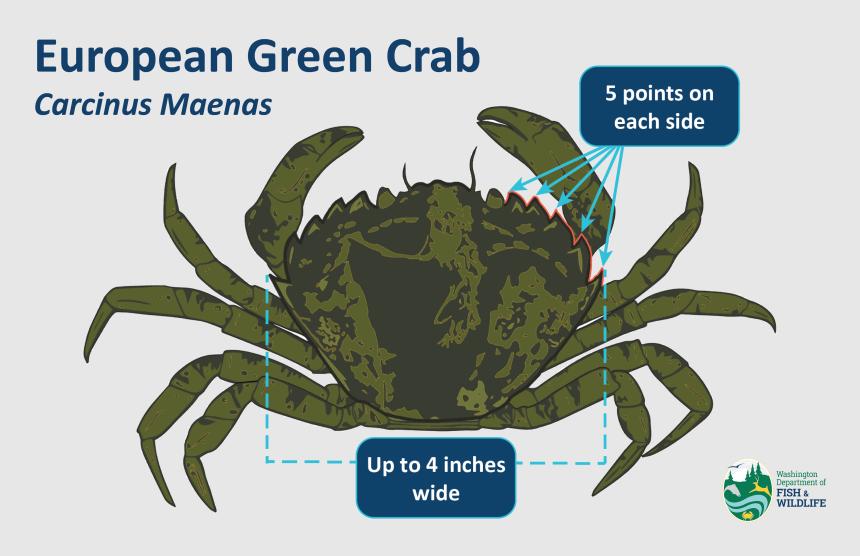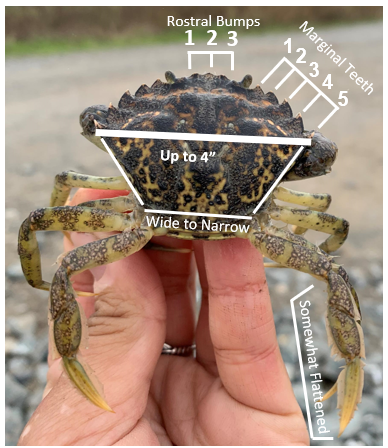If you find a suspected European green crab or its shell in Washington, take photos and report it as soon as possible using the form below. At this time, we are not asking the public to kill suspected green crabs. This may sound counterintuitive but is intended to protect native crabs from cases of mistaken identity. As a Prohibited species, it is illegal to possess a live European green crab in Washington.
Report your sighting
Please enter European green crab for Species in the form below. Take several pictures from different angles to confirm identification. It’s also helpful to include a coin or other object to help show its size. Crab identification guides are available here (PDF) and on our European green crab species webpage. Scroll down for more information.

Other ways to report European green crabs
You can also report European green crab sightings through the Washington Invasive Species Council app.
Or call WDFW Aquatic Invasive Species staff at 1-888-WDFW-AIS (1-888-933-9247).

This webpage includes information for the public on European green crab identification, reporting, and management. For more detailed resources for practitioners and partners as well as regular updates, please visit the European green crab species page.
You can also find catch updates and more information on our interactive European Green Crab Hub, which supports coordination of ongoing emergency measures, data collection, and science.
Refer to this link for a map (PDF) (PDF) showing where European green crabs have been detected in Washington.
A destructive invader
European green crabs are a globally damaging invasive species that pose a threat to Washington's economic, environmental, and cultural resources.
Potential impacts include destruction of eelgrass beds and estuarine marsh habitats, threats to the harvest of wild shellfish and the shellfish aquaculture industry, the Dungeness crab fishery, salmon recovery, and a complex array of ecological impacts to food webs.
For updates see our species webpage or sign up for our European Green Crab Management Updates email list.
How to identify the European green crab
In the Pacific Northwest, there are many small, green native crabs that are easily confused with European green crabs unless you have a trained eye. In addition, green crabs can actually turn quite red as they age. In Washington state, the European green crab is most often confused with native helmet crab or hairy shore crab.
European green crabs are shore crabs and are found in shallow areas—typically less than 25 feet of water—including estuaries, mudflats, intertidal zones, and beaches. They are not likely to be caught by recreational shrimpers or crabbers operating in deeper water, but may be encountered by beachgoers, waders, clam and oyster harvesters, or those crabbing off docks or piers in shallow areas.

Download WDFW's Crabs of Washington identification guide (PDF).
Or visit the Resources section of our European crab species webpage for more identification guides.
Spines
The most distinctive feature of the European green crab is not its color – which can vary from reddish to a dark mottled green – but the five spines or teeth on each side of the shell. This number of spines is different from any other crab you are likely to see on the beach.
Size
At its largest, the back shell (carapace) measures up to 4 inches across, but it is more common to find smaller, younger crabs, often around the size of a quarter. Males are generally larger than females of the same age.
Color
Although known by the common name of green crab, color is not its distinguishing feature. Juvenile crabs can change their shell color to match their surroundings each time they molt. Adults are usually dark greenish with yellow markings, and often have some orange at the joints. The underside of the crab is off-white, but can sometimes be bright yellow or even red.
Shape
The back shell (carapace) is wider at the front than the back. The best way to distinguish the green crab from other species is by the number of spines next to the eye (marginal teeth). The green crab is entirely distinct from other native crabs with its five marginal teeth.
Legs and claws
The green crab has relatively long legs compared to the main body, and narrow claws. The last pair of legs is slightly flattened.
Regulations
WDFW is not asking the public to kill suspected green crabs. This is to protect native crab species, which are often misidentified, particularly helmet, kelp, and hairy shore crabs. It might be hard to let a crab go when you are concerned it could be invasive, but keep in mind WDFW will respond quickly to confirmed sightings in new areas, and the best thing you can do is to get the information to us as soon as possible.
European green crab are classified as a Prohibited Level 1 Invasive Species in Washington, meaning live crabs may not be possessed or retained, introduced on or into a water body or property, or trafficked (transported, bought or sold), without department authorization, a permit, or as otherwise provided by rule.
Under Washington state regulations, prohibited invasive species may be killed and returned to the water where they were found, or retained once dead, if the person is certain about species identification and assumes responsibility for correct identification and adherence to state rules and fishing regulations. This regulation is also included in the crab rules section of the Washington Sport Fishing Rules.
Targeting EGC with traps requires a permit from WDFW's Aquatic Invasive Species (AIS) unit. For those who own or manage shellfish beds, beaches, or tidelands, support and permits for European green crab control may be available. Please contact ais@dfw.wa.gov.
Beachgoers, anglers, recreational crabbers, and others are asked not to tamper with European green crab traps, which are often deployed in shallow areas exposed at low tide and are typically identified with a bright orange buoy and an official green tag or permit.
Are European green crabs edible?
Though considered edible and fished commercially in parts of their native range, European green crabs aren’t any bigger than your fist and don't make the most appealing meal. Where eaten, they are used primarily for crab stock and soup.
WDFW, West Coast tribes, agencies, and other partners continue researching and experimenting with responsible ways to use the biomass from European green crabs that have been trapped, removed from Washington waters, and humanely killed through freezing, including for compost or fish feed.
Join the Washington Sea Grant Crab Team
WDFW has teamed up with the Washington Sea Grant Crab Team who is leading a volunteer-based early detection and monitoring program for European green crab. The Crab Team is also working to improve the understanding of native salt marsh and pocket estuary organisms and how they could be affected by green crabs.
To learn more about early detection, monitoring, and volunteer opportunities, please visit Washington Sea Grant's Crab Team website or check out our European Green Crab Hub, which supports coordination of ongoing emergency measures, data collection, and science.
A European Green Crab Management Updates email list is also available for sign up at wdfw.wa.gov/about/lists.
Limiting the invasion
Native to western Europe, the European green crab first became established the United States in the mid 1800s, arriving by ship to the Cape Cod region. In the early 1900s they spread northwards, where they are believed to have contributed to the dramatic declines in the soft-shell clam fishery as far north as Nova Scotia.
In 1989, green crabs were first discovered on the West Coast in San Francisco Bay, California and made it into Oregon, Washington, and British Columbia coastal estuaries in the late 1990s helped by strong El Nino currents. They were detected in southeast Alaska in 2022.
European green crab were discovered on the Washington coast in 1998 in Willapa Bay and Grays Harbor, and later in Makah Bay. European green crabs were first documented in the Salish Sea at Sooke Basin, British Columbia in 2012, and in the San Juan Islands in 2016.
Beginning around 2018, state and federal agencies, tribes, and partners began to detect significant increases in European green crabs—potentially linked to warmer water conditions, especially in 2021—in areas including Willapa Bay, Grays Harbor, Makah Bay, and Lummi Bay.
While infestations are present at locations along the Washington Coast as well as in Lummi Bay in Whatcom County and Sooke Basin on southern Vancouver Island in British Columbia, European green crab numbers remain low across other areas of the Strait of Juan de Fuca, San Juan Islands, and Bellingham and Padilla bays. They were first detected in Hood Canal in 2022.
European green crabs have not been confirmed in the Salish Sea south of Hood Canal and Whidbey Island. Early-detection monitoring continues across central and south Puget Sound.
For more information and regular updates on European green crab emergency management, please visit this webpage.
Learn about potential impacts from European green crab on Washington's shellfish growers and aquaculture in this March 2022 blog post from the U.S. Fish and Wildlife Service.
For more information on European green crab management in British Columbia, see this webpage from the Invasive Species Council of B.C., or watch this new video from Coastal Restoration Society about green crabs on Vancouver Island.